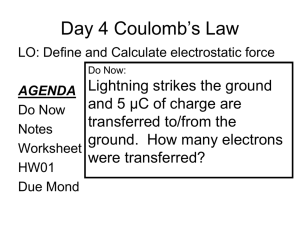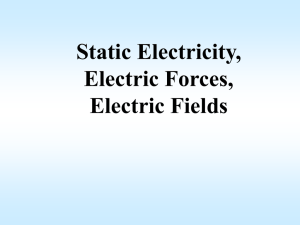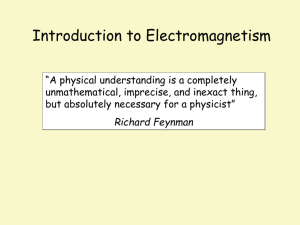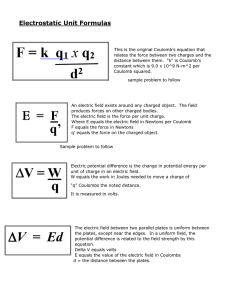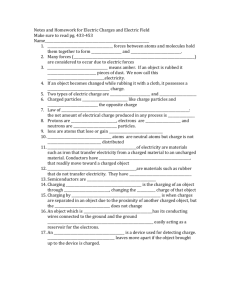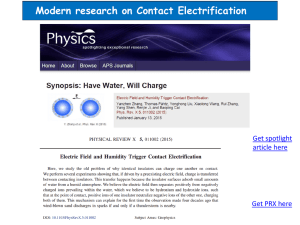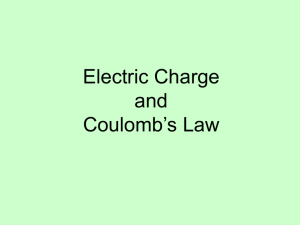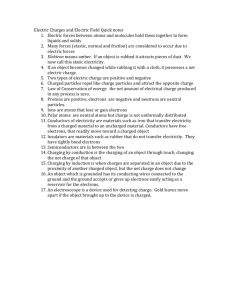Electrostatics - Coulomb's Law
advertisement
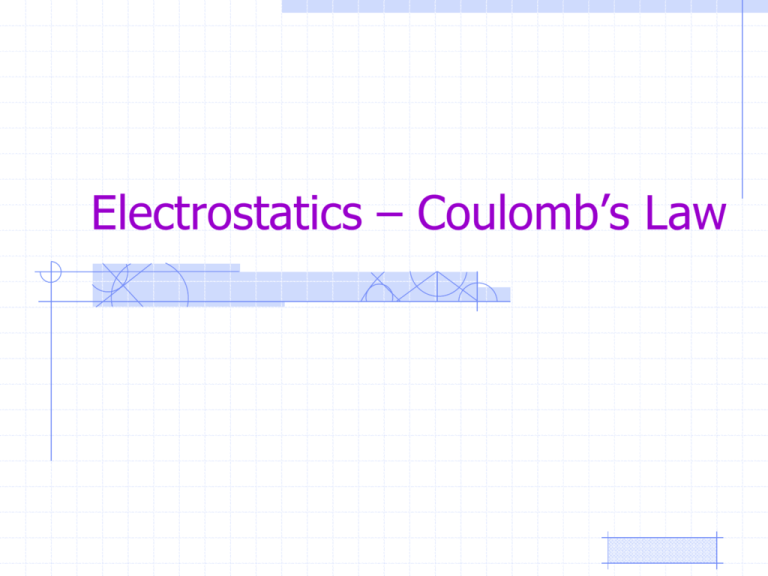
Electrostatics – Coulomb’s Law Tues / Wed Read Chapter 20 pp. 461-470 Homework: p. 477 1-3, 9-12 Wed/Thurs Do problems p. 478 20, 21, 22, 24, 25, 27 Thurs/Fri p. 478 28, 29, 30, 31, 32 Thurs / Fri Lab Fri / Mon Homework: Read ch 21 pages 481-487 Do p. 502 23, 24, 26, 27, 28, 30, 31 Mon / Tues Homework: Read 488-501 Do 32, 33, 34, 42, 43, 47 Coulomb’s Law • Charles Coulomb discovered that the repulsive force due to similar charges or the attractive force of dissimilar charges was inversely proportional to the square of the distance between the two charged bodies. + + + + + + + + + + + + + + + + + + F 1/r2 r _ _ _ _ _ _ _ _ _ _ _ _ _ _ _ _ _ _ _ Coulomb’s Law • Coulomb further discovered that the force was proportional to the product of the charge on each of the objects. q1 + + + + + + + + + + + + + + + + + + Sphere 1 F q1q2 q2 _ _ _ _ _ _ _ _ _ _ _ _ _ _ _ _ _ _ _ Sphere 2 Coulomb’s Law F = kq1q2 r2 Where: k = 8.99 x 109 N•m2/C2 q1, q2 = the charge of each sphere in Coulombs. r = the distance between the two charged bodies. Applet 1 - Coulomb's Law Applet II - Coulomb's Law Example 1: Two point charges, q1 = 1C q2 = 2C are separated by 1 m. What is the force between them? F = kq1q2 / r2 = (8.99E9N*m2/C2)(1C)(2C)/(1m) 2 = 1.8E10N Where: k = 8.99 x 109 N•m2/C2 q1, q2 = the charge of each sphere in Coulombs. r = the distance between the two charged bodies. Example 2: Two point charges, q1 = 1C q2 = -2C are separated by 1 m. What is the force between them? F = kq1q2 / r2 = (8.99E9N*m2/C2)(1C)(2C)/(1m) 2 = -1.8E10N Where: k = 8.99 x 109 N•m2/C2 q1, q2 = the charge of each sphere in Coulombs. r = the distance between the two charged bodies. Example 3: Two point charges, q1 = 1E-19C q2 = -2E-19C are separated by 1E-10 m. What is the force between them? F = kq1q2 / r2 = (8.99E9N*m2/C2)(1E-19C)(-2E-19C)/(1E-10m) 2 = -1.798E-8N Where: k = 8.99 x 109 N•m2/C2 q1, q2 = the charge of each sphere in Coulombs. r = the distance between the two charged bodies. Example 4: At what distance does the electrostatic force between two protons equal 899N? F = kq1q2 / r2 kq1q2 / F = r2 (8.99E9)(1.6E-19)2 / 899 = (2.56E-31) r= 5.05E-16 Where: k = 8.99 x 109 N•m2/C2 q1, q2 = the charge of each sphere in Coulombs. r = the distance between the two charged bodies. Graphs (oh, no, not again.) • Graph of F vs. r? • Graph of F vs. q1q2? Key Ideas • Like charges repel. • The electrostatic force is proportional to the charge on the two objects and inversely proportional to the square of the distance between them.

